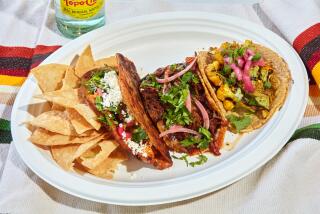Healthy Eating Tips on the Menu
- Share via
Megan Chambers got a few surprises when she visited her local Carrow’s Restaurant recently.
Along with her French fries and chicken fingers, the 12-year-old Santa Paula girl received free bookmarks, puzzles and games.
But these weren’t the usual toy giveaways often used in fast-food industry marketing campaigns.
Instead, these freebies are intended to promote good nutrition and prevent obesity among Ventura County youths as part of an educational campaign spearheaded by the University of California Cooperative Extension. The program works with local restaurants to promote healthy choices among their young customers.
Despite her selection of the “greasy, gross stuff,” Megan said she is well aware of the benefits of good eating habits. She even offered up a defense of her last meal: “I had a salad for lunch.”
This is a good sign Megan’s on the right track, said Leah Haynes, coordinator of a state health program that encourages children and their parents to eat at least five servings of fruits and vegetables a day.
Santa Paula, a small, mostly Latino farm town with one of the highest childhood obesity rates in the county, was the ideal place to launch the Eat Out Smart Campaign, which encourages low-income families to select healthier options from their restaurant menus, Haynes said.
For the past two years, Haynes has persuaded local restaurateurs to allow her to distribute informational pamphlets and goodies to youngsters during March, National Nutrition Month. The four participating restaurants in Santa Paula have also provided additional fruit and vegetable menu options for their customers.
Haynes figured if “table tents” -- beer or dessert advertisements found atop many restaurant tables -- could be used to tout alcohol, they could also be used as part of a grass-roots campaign to change eating habits.
Studies have shown that for numerous cultural and socioeconomic reasons, poor children of color often have higher rates of obesity than their white counterparts.
“Some of these families who are new to the country, I tell them that they would be better off if they ate how they ate in their native land where there was limited meat, plenty of vegetables and they walked a lot more,” said Martha Lopez, director of nutritional programs at the University of California Cooperative Extension. “They get here and are immediately bombarded with so many new options. The kids want chicken nuggets and pizza and parents want to satisfy that.”
Excessive weight puts children at an increased risk of developing diabetes, asthma, high blood pressure, sleep disorders and heart disease. The restaurant table tents -- written in both Spanish and English -- remind families to eat their fruits and veggies and get plenty of exercise. They advise ordering salads with low-calorie dressing, real fruit juice instead of soda and a fruit cup over French fries.
“Early childhood eating practices carry on through adulthood,” Lopez said. “It’s important that they know that they have choices.”
More to Read
Eat your way across L.A.
Get our weekly Tasting Notes newsletter for reviews, news and more.
You may occasionally receive promotional content from the Los Angeles Times.










